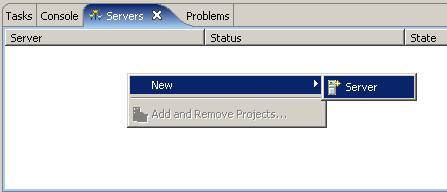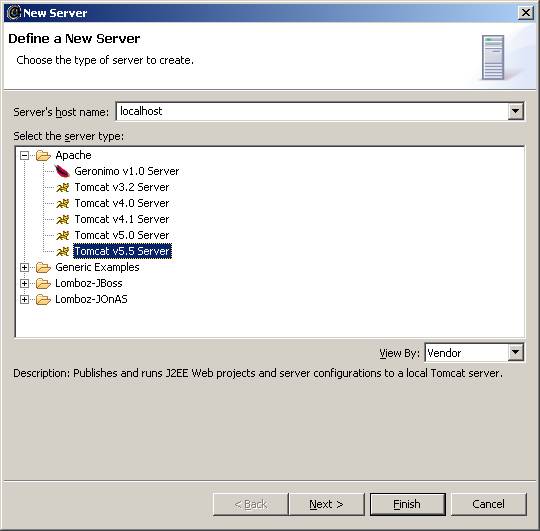Building
a Simple Web Service ? A Tutorial
·
By
Jeevaraj Gnanaselvan Dhanaraj (jeevaraj_1970@yahoo.com)
(Jeeva has over 7 years of experience
in designing and developing enterprise class web applications using JAVA and
J2EE technologies.
He currently works for Itreya Technologies,
Bangalore, leading a team of over 10 programmers and designers, developing a
multi-user, distributed, web-based workflow application)
·
Introduction
In
this tutorial we will create a simple web service and a client web application
using eclipse IDE along with Lomboz
plug
in. We
will also deploy and test the web service on Tomcat 5.5.4 web application
server. This application, while simple, provides a good introduction to Web
service development and some of the Web development tools available.
·
Environment
J2SDK
1.4.2
http://java.sun.com/
Eclipse
3.1
Tomcat
5.5.4
Lomboz
3.1RC2
http://lomboz.objectweb.org/
·
Installation
Install
JDK (in D:\j2sdk1.4.2_04)
Install
Tomcat (in E:\Tomcat5.5)
Install
Eclipse (in E:\Eclipse3.1)
Install
Lomboz (in E:\Eclipse3.1)
·
Setting up
- Set
up the installed JRE in eclipse (Windows -> Preferences -> Java ->
Installed JREs)

- Set
up the installed runtime for server in eclipse (Windows -> Preferences
-> Server -> Installed Runtimes)

- Set
up the Server view in eclipse (Windows -> Show View -> Other)

- Set
up the Tomcat Server by right clicking and selecting New -> Server option
from the Server view in eclipse


·
Creating a Web service
- Create
a new Dynamic Web Project in eclipse (File -> New -> Other)

- Enter
name as ?WebServiceTutorial?, select project location as ?E:\Test?
and select Apache Tomcat v5.5 as the Target server.

- Now
create a new Java class from the Project Explorer (Dynamic Web Projects
-> Java Source -> New -> Class)

- Enter
name as ?Hello? and package as ?com.tutorial?.

- Add
a simple method in the ?Hello? class as below.
public String sayHello(String name){
return "Hello " + name;
}

- Save
and build the project.
- Create
a new Web service in eclipse (File -> New -> Other)

- Select
Generate a proxy.
- Select
Test the Web service.
- Select
Overwrite files without warning.

- Select
or enter the Bean name as ?com.tutorial.Hello?. This is the java class
that we just now created.

- Continue
the wizard by clicking Next and finish.
- On
Finish, the Tomcat server starts up and launches the Test client.
- Verify
the generated contents. Look for Hello.class and the generated JSPs as
below.

- Verify
the Tomcat folder and ensure the newly created web applications ?
WebServiceTutorial, WebServiceTutorialClient.

- We
can also run the following url from the browser to access/test the Web
service.
http://localhost:8080/WebServiceTutorialClient/sampleHelloProxy/TestClient.jsp
- If
servlet error ?org.eclipse.jst.ws.util.JspUtils cannot be resolved or is
not a type? is thrown on the browser, then copy the webserviceutils.jar
file from the E:\Eclipse3.1\eclipse\plugins\org.eclipse.jst.ws.consumption_0.7.0
into the WEB-INF\lib folder of the WebServiceTutorialClient application and
restart the Tomcat server.
- The
browser displays the methods available in the web service.

- Click
on the sayHello(..) method, enter your name (for e.g. ?Jeeva?) in
the inputs section and click ?Invoke?.

- The
browser greets using the web service.

- The
WSDL for the Hello Web service can be found in E:\Test\WebServiceTutorial\WebContent\wsdl\Hello.wsdl.
On double-click, the WSDL opens in a graphical editor.

- Right-click
on the WSDL file and explore the options to test the web service / publish
the WSDL file / generate client / etc.

·
Conclusion
In this
tutorial we learned how to create a simple web service and a client web
application using eclipse IDE along with Lomboz
plug
in. We
also deployed and tested the web service on Tomcat 5.5.4 web application server.
This application, while simple, provides a good introduction to Web service
development and some of the Web development tools available.
